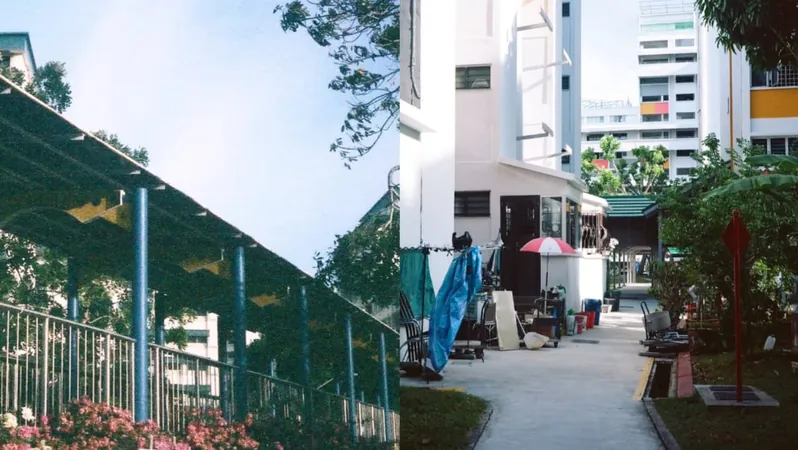
Singapore's Nostalgia: A Deep Dive into Our Longing for the Past
2025-05-18
Author: Jia
The impending closure of Isetan's Tampines Mall outlet in November 2025 marks the end of an era for many Singaporeans. For almost thirty years, this department store has been a cornerstone of the local shopping experience, representing the quintessential Singaporean mall filled with nostalgia.
Recent years have seen many beloved businesses fade into memory, particularly in areas like Holland Village, home to long-standing institutions like the Thambi magazine store and Khiam Teck party shop. Even the beloved pastime of going to the movies is evolving, with Filmgarde Cineplexes shutting down after nearly two decades and Cathay's operator closing multiple theaters over just a few years.
As these familiar faces disappear, public sentiment rallies around nostalgia, evoking deeper feelings than mere longing for the past. It raises important questions about our collective identity: Are we mourning what once was, or are we grappling with how these changes reflect who we are today?
Understanding Our National Identity
For many, being Singaporean means more than just our unique habits like "chope-ing" (reserving seats with tissue packets) or our efficient transport systems. It’s about the feelings tied to these experiences and the memories that have shaped our lives.
Nostalgia is particularly pronounced in a rapidly changing urban landscape, leading millennials, in particular, to question their connections to the past. As social media amplifies these sentiments, groups like Heritage SG Memories showcase shared experiences of lost landmarks, igniting collective reminiscing from even those who have never directly experienced them.
Photographers like Jonathan Tan highlight a longing for the past through projects like Lepak Downstairs, capturing the simple designs of HDB void decks and emphasizing the emotional weight behind disappearing local aesthetics.
Navigating Nostalgia and Change
In the midst of this nostalgia lies a complex tension. Dr. Felicity Chan from SUTD explains that the Singaporean experience involves navigating the fine line between cherishing what we have while adapting to inevitable change. This paradoxical existence requires adaptability, yet Singaporeans continuously seek stability in a chaotic world.
As more places close down, many feel a psychological strain, realizing that each loss signifies not just a change in their environment but a bit of their childhood altogether. The yearning for a "home" rooted in familiarity drives a desire to preserve the past amidst relentless modernity.
Embracing, Not Avoiding Nostalgia
Some suggest that minimizing attachment to places and establishments could help ease the pain of loss, but this perspective undermines our human nature. Forming connections is intrinsic to who we are, making it impossible to dismiss nostalgia entirely.
Young people today also grapple with feelings of nostalgia, as they are constantly bombarded with stories of urban change, making them aware of their own longing for simpler times. Embracing nostalgia as a foundational part of identity construction may reveal significant emotional links to their early life experiences.
Experts believe that respecting and honoring our heritage without dwelling overly on loss could facilitate a more constructive dialogue about progress and cultural integration. The question shouldn't be whether to develop but how to weave the narrative of our past into our future.
In a nation defined by transition, it’s crucial to remember that while not every facet of life is meant to endure, the imprint of our experiences can last a lifetime. Nostalgia isn’t just a longing; it's a vital thread connecting us to our identity in a landscape defined by constant change.




 Brasil (PT)
Brasil (PT)
 Canada (EN)
Canada (EN)
 Chile (ES)
Chile (ES)
 Česko (CS)
Česko (CS)
 대한민국 (KO)
대한민국 (KO)
 España (ES)
España (ES)
 France (FR)
France (FR)
 Hong Kong (EN)
Hong Kong (EN)
 Italia (IT)
Italia (IT)
 日本 (JA)
日本 (JA)
 Magyarország (HU)
Magyarország (HU)
 Norge (NO)
Norge (NO)
 Polska (PL)
Polska (PL)
 Schweiz (DE)
Schweiz (DE)
 Singapore (EN)
Singapore (EN)
 Sverige (SV)
Sverige (SV)
 Suomi (FI)
Suomi (FI)
 Türkiye (TR)
Türkiye (TR)
 الإمارات العربية المتحدة (AR)
الإمارات العربية المتحدة (AR)